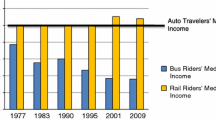Abstract
The purpose of this paper is to discuss various types of behavioral data of potential relevance to transit planning. In particular a distinction is drawn between behavorial information regarding feelings, attitudes, opinions, and the like and more sophisticated types of data dealing with individuals' intentions to respond in certain ways given certain configurations of stimuli (transportation variables). The former is shown to be an important input to incremental planning, i.e., where information as to system performance is desired. The latter is shown to be critical to decisions regarding manipulations of transit system parameters, i.e., where knowledge of the outcome of manipulating system parameters is desired.
A methodological example as to how the first type of data — informational level data — can be collected and utilized in system planning is presented. Specifically, data collected along the lines of traditional attitude surveys is collected in an attempt to monitor changes in public “satisfaction” with the Iowa City, Iowa, bus system before and after major system innovations. Implications of the collection and analytical procedures are discussed.
Similar content being viewed by others
References
Anderson, N. H. (1972). “Information Integration Theory: A Brief Survey,” CHIP 24, Center for Human Information Processing, University of California, San Diego, La Jolla, California.
Anderson, N. H. (1970). “Functional Measurement and Psychophysical Judgment,” Psychological Review, 77, 153–170.
Curry, L. (1967). “Central Places in the Random Spatial Economy,” Journal of Regional Science, 7, 217–238.
Olsson, G. (1971). “Correspondence Rules and Social Engineering,” Economic Geography, 47, 547.
Porteous, J. D. (1971). “Design with People: The Quality of the Urban Environment,” Environment and Behavior, 3, 156.
Rushton, G. (undated). “Postulates of Central Place Theory and Properties of Central Place Systems,” Mimeo, the Department of Geography, the University of Iowa.
Stevens, S. S. (1970). “Neural Events and the Psychophysical Law,” Science, 170, 1043–1050.
Teitz, M. B. (1971). “Some Observations on Policy Analysis in New York City,” Papers of the Regional Science Association 27, 255.
Author information
Authors and Affiliations
Additional information
This report was produced as part of a program of research and training in urban transportation sponsored by the Urban Mass Transportation Administration of the Department of Transportation.
Rights and permissions
About this article
Cite this article
Horton, F.E., Louviere, J.J. Behavioral analysis and transportation planning: Inputs to transit planning. Transportation 3, 165–182 (1974). https://doi.org/10.1007/BF00219616
Issue Date:
DOI: https://doi.org/10.1007/BF00219616




